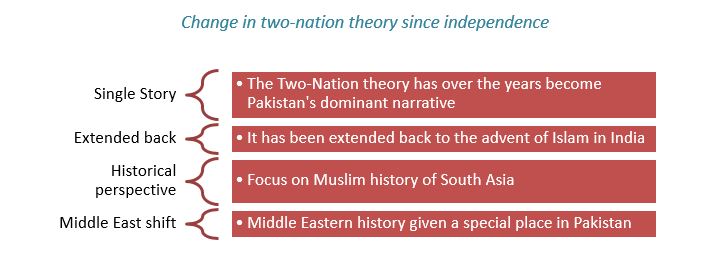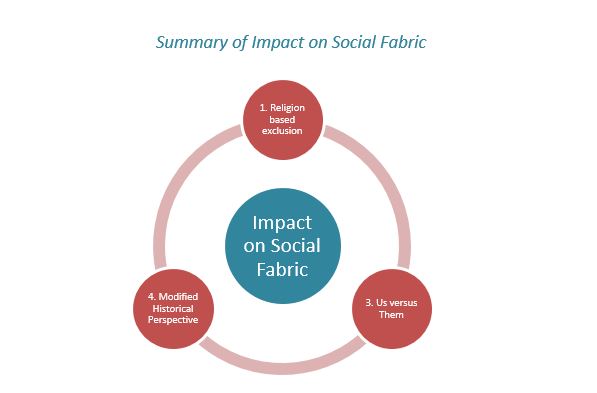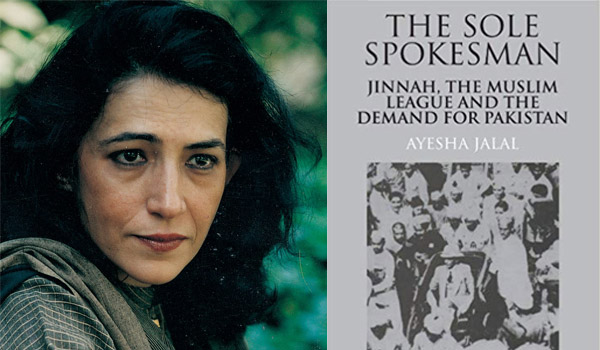
Muhammad Khudadad Chattha explains the evolution of the theory over the last decade and its impact on the social fabric.
The Two-Nation Theory explained
The two-nation theory formed the basis of the partition of India and the creation of Pakistan in 1947. The theory simply states that Muslims and Hindus of South Asia are two different nations based on their contrasting and incompatible religions. This theory implied two viable scenarios for Muslims of India once the colonial rule ended. In the first scenario, the Muslim majority provinces would become a part of a loose Indian confederation with the option to secede. This would work as a counterweight to potential discrimination against Muslims in Hindu dominated provinces. In the second scenario, Muslim majority provinces would be made into a separate country. This would involve mass migration of Muslims and non-Muslims in South Asia. The second scenario became the reality in 1947 with the formation of Pakistan.
While the differences in the lifestyles of Hindus and Muslims had been identified by thinkers such as Al-Biruni as early as the 10th century, it wasn’t until the 19th century that the idea of two nations was brought into the popular discourse.
Sir Syed Ahmed Khan, who was a leading Muslim reformer in the 19th century, first articulated the idea that the two religious communities were two separate nations. Sir Syed saw his fear of Hindu domination confirmed during the Hindi-Urdu controversy of 1900 when Anthony MacDonnel, who was the governor of United Provinces, replaced Urdu with Hindi as the official language.
Since Urdu was predominantly spoken by Muslims of British India, Sir Syed Ahmad Khan reacted to this move by articulating his thoughts about how Muslim rights were not being protected in Hindu majority areas.
Sir Syed’s thoughts were in no way a demand for a separate country for Muslims of South Asia. He was simply pointing out the differences between both cultures and voicing his disappointment at the lack of protection of rights of Muslims in South Asia. But since he used the modern concept of the nation to articulate his thoughts, this formed the foundation for what become the Pakistan movement in the 20th century.
Competing views before independence
As the two-nation theory came into the hyperspace of ideas about nations and the coexistence of different communities, it was competing with several other perceptions of reality. These ideas came from different political players explaining their vision of the future of South Asia once the British left. Some of these views that were more popular compared to the two-nation theory, even as late as 1939, are given below.
Secular nationalists claimed that peaceful coexistence is possible between Hindus and Muslims of South Asia and that the demand for a separate country is illegitimate based on the two-nation theory. These secular nationalists, however, did overlook the grievances of the Muslim community by stating that there is no problem of systematic discrimination and economic inequality that led to the two-nation theory becoming popular. These very secular nationalists often ignored the concerns of Muslims that polarized the communities even further.
Muslim religious scholars claimed that Islam should not be restricted to the boundary of nation state and hence lobbied for a united India after the British left. This is surprising because religion became the popular expression of differences between communities in 1947 in spite of the fact that religious scholars were firm in their opposition of the two-nation theory.
Muslim modernists were interested in protecting the socio-economic rights of Muslims and lobbied for adequate representation in politics and civil service in a united India. These modernists were in the same camp as the ones who later on championed the two-nation theory. It can be argued that Pakistan’s founding father, Muhammad Ali Jinnah, was in this camp as late as 1945 where he used the threat of secession only to lobby for rights in a united India. However, by 1947, this category of thinkers was small because by that time, most Muslims had rallied behind the two-nation theory.
Hindu nationalists claimed that India should be a Hindu country. The interesting fact is that while Hindu nationalists did realize the differences between Muslims and Hindus in South Asia and often said some of the same things pointed out by the two-nation theory, they did not want Muslims to get a separate country for themselves.
They were critical of the Indian National Congress for conceding Pakistan in 1947 and later outraged by Gandhi’s fast to protest against the Indian government not paying Pakistan’s due of Rupees 500 million from the partition.

As these ideas competed against each other, the least popular of all ideas till early 1940s, the two-nation theory, won out. The dramatic rise of this idea can be gauged by the fact that the major political party that mobilized on Sir Syed’s idea, the All India Muslim League, won only 1 seat in the provinces of Punjab, Sindh and NWFP in the provincial elections of 1937 under the devolution enacted through the Government of India Act of 1935.
These provinces constitute modern day Pakistan. Fast forward to 1945 - during the election of the first constituent assembly, the All India Muslim League was able to win all Muslim seats.
This spectacular rise of the Muslim League and the two-nation theory within a span of 8 years shows how quickly the political narrative changed, especially within the Muslim community. While it is difficult to explain the exact reasons behind this change in popular narrative, historians have hinted at some potential causes given below.
Also read: Frozen Tears – A Tale of Ruination and Human suffering devoid of Humanism
First, the Congress rule after the provincial elections of 1937 has been hypothesized to have contributed to the resentment in the Muslim community. The use of popular Hindu symbols in administration meant that the Muslim community felt excluded even when most of them had voted for The Congress. One example is making it mandatory for students in schools to sing the song Vande Mataram which was an ode to the Indian motherland. Since this song used Hindu symbols, including a reference to the Hindu goddess Durga, Muslims found the imposition of singing the song to be insensitive. The resentment can be seen from the fact that when the Congress government resigned in 1939, in protest for not being consulted by the British government on its decision to enter the second world war, the day was celebrated as the Day of Deliverance by Muslims.
Second, the Muslim League suffered from an image problem of being an elitist political party. This was true because it was mostly composed of Muslim aristocrats. However, the loss in 1937 meant that the party reorganized itself and tried to connect more with the population at large. They also picked up on the failings of the Congress between 1937-39 to make the case for why the two-nation theory was right.
Third, a combination of British haste in leaving the Indian subcontinent, miscalculations by the Congress and communal politics that exaggerated the differences between different religious communities. This ended up polarizing communities across South Asia and led to the communal violence of 1947.
While this is not an exhaustive list of potential causes, it helps understand some of the reasons why the popular narrative in the Muslim world changed.
Two-Nation Theory becomes Pakistan’s “single story”
Once Pakistan was created, the two-nation theory became an integral part of the Pakistani narrative on the events that led up to the independence. While it was a fringe idea before the 1940s, Pakistan’s existence and the communal violence along religious lines that broke out in 1947 over the partition of India gave credence to theory. While the popular narrative in India about the partition saw this as a tragedy and attributed it to British mistakes, the popular narrative in Pakistan saw it as a logical conclusion of the two-nation theory.
After 70 years on consistent reiteration of the two-nation theory in mass media, educational textbooks and intellectual discourse, where it has gone virtually unchallenged, it is not the same contested worldview that it was before Pakistan was made. As a result, the theory itself has undergone change. There are four key differences between it today and 70 years ago.
First, the two-nation theory in modern Pakistan has become the only narrative to explain the partition in 1947. Other narratives are often blamed as being unpatriotic.
Second, in a classic ex-post rationalization style, the theory is extended back to the advent of Islam in the Indian subcontinent. Muslim invaders from the middle east, like Muhammad Bin Qasim in the 8th century, are hailed as saviors and their brutalities are overlooked. On the other hand, Hindus are depicted as an enemy who did not want to safeguard Muslim interests.
Third, the historical perspective focuses more on Muslim dynasties in South Asia, like that of the Mughals. Other dynasties are not given as much importance. This can be seen from the syllabus of any Pakistan Studies high school textbook used in government schools. Pakistan Studies was introduced as a mandatory subject for everyone till undergraduate education during Zulfiqar Ali Bhutto’s government in the 70s.
Fourth, at a broader level, the historical narrative shifted towards associating more with the middle-east compared to the Indian subcontinent. One way of such association was to see Islamic contributions to science and art, that were primarily in the Middle East, as Pakistan’s own. Interestingly enough, there is always a section about Muslim scientists and philosophers in history and science books for most high schools. In short, the two-nation theory was also extended towards pan-Islamism.

Change in two-nation theory since independence
As can be seen from the illustration above, the two-nation theory has changed significantly over the last 70 years and has taken the central stage in the official Pakistani narrative.
Impact on the social fabric in Pakistan
The change in the meaning and importance of the two-nation theory had dramatic consequences for the social fabric in Pakistan. There are three that clearly stand out.
First, exclusion based on religion has been normalized because other minorities are not seen as being part of the nation. Had the narrative around Pakistan’s creation been built around the protection of minority rights, it would have enabled a more inclusive approach. While there are a lot of other factors that explain religious discrimination in Pakistan, the foundational principle that Muslims are one nation does not include anyone else, making such discrimination easy.
Second, at a larger level, a ‘Muslim versus the rest’ narrative has become easier to popularize. While most organized religions across the world have some sort of us versus them connotation where the excluded group is often considered to be in error, these ideas often stay at a local or community level.
The presence of the two-nation theory meant that it could be twisted in a way that this religious narrative can become popularized. This might have fostered unity among Muslims within Pakistan. At the same time, it makes it difficult for Pakistan to integrate into a larger pluralistic world.
Third and last, Pakistanis have come to associate themselves with only the Muslim history of the Indian subcontinent. While the ancestors of most Pakistanis were either Sikh or Hindu and were converted a few centuries ago, this part of the heritage is not given as much importance. Similarly, Muslim invasions of the Indian subcontinent such as the ones by Muizuddin Ghauri from modern day Afghanistan, aren’t really seen as invasions. Hence, Pakistan’s historical perspective has become skewed because of the dominance of the two-nation theory.

Summary of Impact on Social Fabric
Challenging the dominant perspective
Various intellectuals, political activists and celebrities have come forward to challenge the dominant perspective of the two-nation theory over the years. While these efforts have been unable to change the dominant perspective, they have certainly put the two-nation theory back in a position where it is competing against other worldviews. The three most important challenging views that have slowly crept into the popular discourse as alternatives are explained below.
First, one of the most prominent Pakistani historians, Ayesha Jalal, has argued that Muhammad Ali Jinnah never intended on getting a separate country for Muslims in South Asia. He simply used the threat of secession to get more representation for Muslims in United India. She argues that the partition was never meant to happen in the first place.

Second, Academics such as Hamza Alavi, who was also a prominent activist and Marxist, have posited that Pakistan was made due to the vested interests of the landed elite in South Asia. They use the fact that Pakistan was not able to implement any land reforms after independence due to elite capture while India was able to do so successfully, as a basis of their thesis. Since individuals like Hamza looked at the world through a leftist and Marxist lens, beyond religion, they saw a class struggle where the elites were able to get a separate country in order to protect their land ownership. This perspective has added to the breadth of views on the formation of Pakistan. However, it is one of the contributing factors in the Pakistan movement and was unable to become a serious contender to the main narrative.
The last view is a reinterpretation of the two-nation theory. Since the two-nation theory simply points towards the differences of Hindus and Muslims and does not say that these differences are irreconcilable, academics have reinterpreted it as implying that the differences need to be recognized and addressed. In other words, they claim that Pakistan’s creation can be justified in a better manner using liberal values of protection of minority rights. While this group is small, it has grown considerably over the last two decades.
